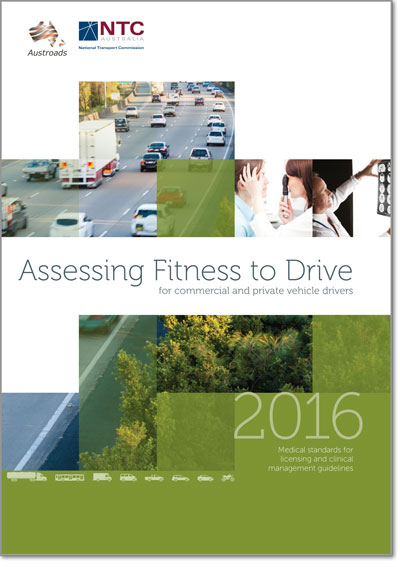October 1, 2016, marked the revised edition of ‘Assessing Fitness to Drive” Guidelines – a much awaited joint publication of the National Transport Commission (NTC) and Austroads.
Did this updated rendition sneak under your radar? It didn’t sneak past us! Here are the key take outs we got from this year’s changes and how it might affect you as a GP, health professional or driver. You’ll notice there are plenty of links to further information to guide you through these changes.
Which medical conditions have a revised medical criteria?
A variety of medical conditions can impair your driving ability. Out of the ten detailed in the “Assessing Fitness to Drive” guidelines, six have amended medical criteria to account for developments in medical understanding and practice. These are:
- Cardiovascular conditions; Diabetes; Hearing; Epilepsy; Vestibular conditions; Vision and eye disorders
Now, reading through the 188 pages of the new revised edition might be an eyesore, but we have collated the summary links here for your convenience. If you’ve got some time on your hands, the 47-page Summary is for you, otherwise, there is a three-page summary of the key changes found in the Information kit. Some of the changes include:
- Diabetes: ‘a new questionnaire (Clarke Questionnaire) has been included to help identify drivers who may have reduced awareness of hypoglycaemia’ (National Transport Commission & Austroads, 2016a, p. 13)
- Neurology – vestibular conditions: ‘the section was deleted and an advisory-only paragraph was added to ‘Other neurological and neurodevelopmental conditions’.’ (NTC & Austroads, 2016a, p. 14)
- Neurological conditions – other (Stroke): ‘For private vehicle drivers, the requirement for a conditional licence and periodic review has been removed if the driver has recovered adequate neurological function’ (NTC & Austroads, 2016a, p. 14)
- Vision: ‘a driver no longer meets the requirements for an unconditional licence if there is any significant field loss (scotoma) with more than four contiguous spots within 20 degrees radius from fixation’ (NTC & Austroads, 2016b, p. 5).
We highly recommend that if these conditions concern you that you take a look at the relevant information or speak with your GP.
I’m a health professional, what are the key changes I need to be aware of?
Overall, there appear to be clearer reporting obligations and improved general guidance.
- The new Assessing Fitness to Drive guidelines feature flow charts to guide assessments of conditions including epilepsy, dementia and hearing loss and a questionnaire to assist assessment of drivers with diabetes and more.
- The standards acknowledge that providing advice on fitness to drive for people with dementia is complex. Links to resources developed by Alzheimer’s Australia to assist health professionals to engage clients in conversations about driving are now included in the revised edition.
If I’m a GP, what’s of particular interest?
- Mandatory reporting of a person’s likely risk to endanger the public if they continue to drive is still enacted in South Australia and Northern Territory
I’m a driver, how will the changes affect me?
From October 1, 2016, all drivers should be assessed using the new “Assessing Fitness to Drive” standards.
- If you have an existing medical condition or a conditional license, or have other driving restrictions you should speak to your health professionals involved or your local Driver Licensing Authority if you have any concerns. Driving Licensing Authorities will notify you via post if there are any changes to your current conditional license as a result of the changes.
- You still have the same responsibility to not drive if you have a condition that is likely to affect your ability to drive safely, and to report such conditions to the Driver Licensing Authority. The South Australian Driver Licensing Authority can be contacted on 13 10 84 or via email at enquiriesadministrator@sa.gov.au
Want to know more about the “assessing Fitness to Drive” guidelines?
If you are waiting for your hard copy of the new “Assessing Fitness to Drive” guidelines, it won’t come to you! Austroads are no longer distributing, and instead, your copy can be purchased or downloaded from their website.
Become a subscriber to the Austroads website and receive email updates about Assessing Fitness to Drive.
References:
National Transport Commission & Austroads, 2016a, Assessing Fitness to Drive 2016 | Information kit, NTC & Austroads, viewed 16 December 2016, <https://www.austroads.com.au/images/assessing-fitness/AFTD2016_Information_Kit_Sep2016.pdf>.
— 2016b, Reviewing Assessing Fitness to Drive: Summary, NTC & Austroads, viewed 16 December 2016, <https://www.austroads.com.au/images/assessing-fitness/AFTD-Summary-Final-Report-Aug2016.pdf>.
A bit about the author:
Bettina Stefani is an Occupational Therapist and recent graduate of the Occupational Therapy Driver Assessment and Rehabilitation post graduate program co-facilitated by the University of South Australia and the Flinders University.
She is currently working in the Community Geriatrics Service as an Occupational Therapist. In her spare time, she enjoys spending quality time with her husband Kristian, family and friends, and being active in a myriad of activities including soccer and bushwalking.
What excites her about driving is the identity it bestows on a driver and the opportunity, as a Driver Trained OT, to engage, re-engage or maintain that identity for someone.



